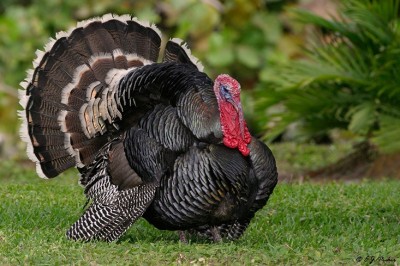When the first Europeans arrived in North America, they discovered a strange-looking bird that was stealthy in the woods, could run like a velociraptor and fly to boot! They also discovered that this fowl was quite tasty, and it is a well-established fact that my ancestors dined on this noble bird on that first Thanksgiving. That’s right, I’m a Mayflower descendent, so I guess you could say that me and the birds, turkeys to be exact, go way back.
Turkey were, of course, a wild bird, and they were wrongly labeled “turkey fowl” because Europeans believed they were part of the guinea fowl family that were thought to originate in the country of Turkey. The name stuck. Turkey (the birds) have spread across the globe starting around the year 1550. A lot can happen in half a millennium, and domestic breeds of turkey are a staple on many farms and homestead across the globe.
Raising the Thanksgiving Bird
When I was growing up, our neighbors had more than 20 turkeys and around 30 chickens raised on huge lots. Often, the birds would escape and we would wake up with a turkey gobbling at us, perched on our Chevrolet. When I started working for a local farmer, we raised a few birds on the farm along with the chickens.
All The Answers To Every Chicken Question And Quandary … [2]
Raising turkeys is not difficult. Most likely, you will start raising the birds from poults purchased from breeders or farm-supply stores in the spring. Here you can choose between a heritage breed or a breed tailor suited for meat production, such as a broad breasted white. You will need to carefully care for your new poults the same as you would care for chicken chick hatchlings. Heating lamps, and a dry and warm facility, are necessary for this stage. Water and feed are equally important. After the birds have feathered out, you can move them outdoors.
I have used two methods to raise turkey outdoors. One involves a large fenced-in grass pasture with high fencing and roosting boxes. The other method is to use a “chicken tractor [4]” and move these birds around the farm every couple of days. With both options, I also supplement with a protein feed. Fencing needs to be high to prevent the birds from flying out. You can free-range the birds with a movable roost, but I have found this leads to the most loss. With a good “tractor,” I minimalize loss and improve meat quality through almost free-ranging the birds.
I have had to deal with predators before, and I have had to hunt down a few foxes and coyotes who thought they could help themselves to my fowl. A few late nights and some well-placed .22WMR rounds fixed the problems and I do suggest you keep a rifle handy for varmint.
Keep Your Livestock Healthy With ‘God’s Miracle Dust’ [5]
Good fencing prevents much of the loss, as does a heavy and well-built chicken tractor. I have had more predation with chickens than I have with turkey, but fowl of any kind will attract the attention of predators.
Eating the Thanksgiving Bird
It has typically taken me four months to grow a turkey to a 13- or 14-pound bird, and six to seven months to grow a bird that weighs in over 19 pounds. Sure, others report faster or slower results, but this is what I have come to expect. You may experience different results with the growth of your fowl, and that is normal. If you just free-range, expect your birds to weigh less and take a little longer to reach a good weight. However, a free-ranged bird is very tasty.
I have found the easiest way to slaughter a bird is a method I read about online a few years back. Catch the turkey and place it in a feed bag with a hole large enough for the bird’s head to fit through. I use a good ax or hatchet, and with a swift stroke I remove the bird’s head. After I dress, feather, and prepare the bird I often brine it for 12-24 hours and let the turkey rest for 24-48 hours before cooking.
You also may be interested in:
How Chicken Tractors Can Increase Egg Production – And Get Rid Of That Nasty ‘Coop Smell,’ Too [4]
Have you raised turkey? Do you have any tips? Share them in the section below:

